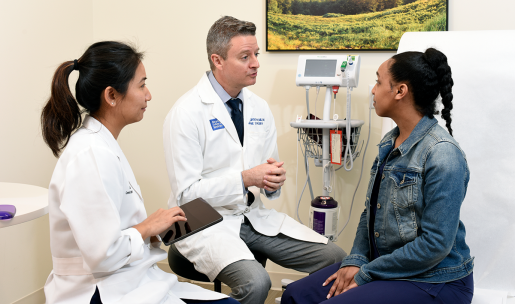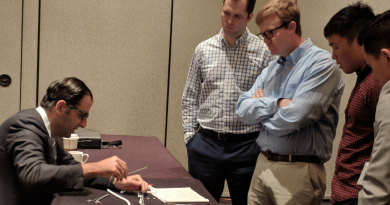Thyroid surgery: reflecting on the past and looking to the future

Thyroid surgery as we know it today started around 1900, says Dr. Raymon Grogan, Baylor Medicine endocrine surgeon. Steady advancements over the last 20-plus years have led to positive patient outcomes, less scarring and even faster recovery time.
Dr. Emil Kocher, a surgeon in Switzerland, received the 1909 Nobel Prize in Physiology for his work in physiology, pathology and surgery of the thyroid. Significantly, he identified the anatomy properly, found ways to control the blood supply to the thyroid, and discovered that the thyroid produces a hormone essential for life. Before Kocher’s discovery, doctors didn’t realize they needed to replace the hormone after removing the thyroid, so the mortality rate was very high. But thanks to his work, hormone replacement started, and the mortality rate decreased dramatically.
The same operation Kocher pioneered was performed until about 2000. Then, surgeons started experimenting with remote-access thyroid surgery or minimally invasive surgery. This included using small incisions using cameras, no incisions on the neck and moving the incisions to the armpit or the upper chest wall. Most recently, surgeons have developed a new technique that involves putting incisions inside the upper lip using laparoscopic instruments. The technical term for this operation is TOETVA, but it is more colloquially known as the Transoral Thyroidectomy technique. The operation is not performed through the mouth but in a space known as the oral vestibule, which is the space between the lower lip and the bottom teeth. These newer remote-access operations have been studied for about 20 years, and the transoral approach seems the best method.
The transoral approach is where the surgeon will pass small, laparoscopic instruments about the diameter of a pen between the lower lip and the bottom teeth to get to the thyroid. “We can access the thyroid and remove it with very good outcomes, which are equivalent to the traditional surgery, which requires an incision across the front of the neck,” Grogan says.
The main advantage of this new transoral technique is the lack of scar on the neck. Grogan says traditional thyroid surgery differs from other surgeries, which often have scars in less noticeable areas. The scar from traditional thyroid surgery, however, is very visible and prominent to both the patient and the people around them. Being able to do a remote-access approach removes the very visible scar from the front of the neck.
Another new development in thyroid surgery includes radiofrequency ablation (RFA) of nodules. This is the latest treatment for thyroid disorders. Ablation is when the surgeon inserts a needle into the tissue and applies energy to that tissue, which essentially kills it. Grogan explains that ablation techniques have been around for decades and used in various parts of the body, including the liver and the brain. However, surgeons have started using this technique for thyroid nodules within the past five years. Non-cancerous thyroid nodules that are large and symptomatic for patients, pushing on the windpipe and even showing sometimes, can be treated with RFA. For this procedure, the surgeon inserts a needle inside the nodule and applies the energy to kill the surrounding tissue, which causes the nodule to shrink and relieve the uncomfortable symptoms.
This procedure has a few benefits over the traditional or remote-access approach.
“The main benefit is that it preserves your native thyroid tissue,” Grogan says. “When we remove a thyroid for a cancer or nodule, we inevitably remove part of the thyroid that has normal tissue as well. In the case of ablation, we are targeting the nodule, causing it to shrink, and it is leaving behind the native thyroid tissue. The big advantage is that we don’t have to worry about a reduction in thyroid hormone production.”
Grogan further explains that in surgery, if half the thyroid is taken out, there is a 20-30% risk of needing to take thyroid medication, and if the whole thyroid is taken out, the patient must take medication for the rest of their life.
Another benefit of RFA is that a patient can get back to work the next day whereas surgery requires five days to recover. Additionally, the complication rates are lower with ablation than with surgery. Grogan says one drawback to RFA is the nodule takes six to seven months to shrink or may require more than one treatment, while surgery fixes the nodule instantaneously.
Many conditions can arise in the thyroid that may require surgery, including cancers, Graves’ disease and large thyroids (goiter). Grogan and his colleagues treat these in various ways and discuss all options with patients, including the risks, benefits and alternative treatments. “It is really a back-and-forth discussion between physician and patient to try to understand what the objectives of the patient are and how we can best achieve those objectives. Often, these aren’t medical decisions; they’re personal decisions based on how a patient wants to live their life.”
By Tiffany Harston, communications specialist in the Michael E. DeBakey Department of Surgery



